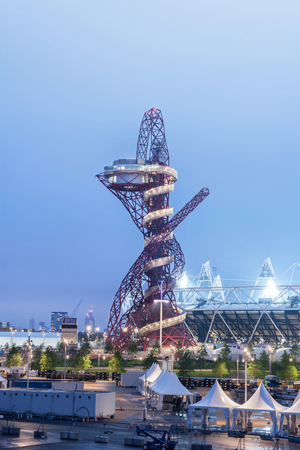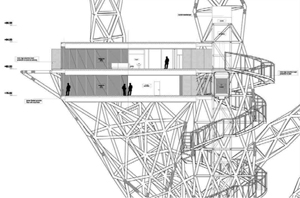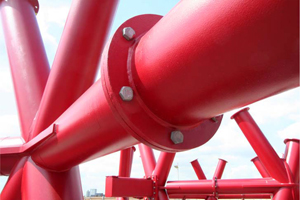 |
 |
 |
 |
 |
 |
| |
 |
|
 |
 |
 |
  |
  |
 |
 |
 |
 |
|
|
 |
|
 |
 |
 |
BUILDING |
 |
|
 |
|
 |
 |
 |
| |
 |
| 
 |
ArcelorMittal Orbit
|
|
 |
 |
 |
 |
DESIGNER |
 |
|
|
 |
|
 |
 |
 |
| |
 |
|
 |
 |
 |
 |
DESCRIPTION |
 |
|
|
 |
|
 |
 |
 |
| . |
 |
|
 |
 The ArcelorMital Orbit is designed by Cecil Balmond and Anish Kapoor. It engages with a new kind of language of ‘tower’. Instead of going up linearly, in a straight line, their creation is an ‘orbit’ - a continuous loop from the start to the finish that goes around and comes back on itself. By turning, looping and connecting up every time it passes itself, a unique, highly stable structure is created that compiles space around you, as you move up and down. It is a fully 3-dimensional invention of space evoking human values to delight in ‘play’ and enjoy in its surfaces, materiality and shape making. Balmond has described the ArcelorMittal Orbit as a “narrative in space” that “stretches the language of the icon. Artists will read art into it. Architects will read structure into it. Engineers will absolutely read engineering into it.” The ArcelorMital Orbit is designed by Cecil Balmond and Anish Kapoor. It engages with a new kind of language of ‘tower’. Instead of going up linearly, in a straight line, their creation is an ‘orbit’ - a continuous loop from the start to the finish that goes around and comes back on itself. By turning, looping and connecting up every time it passes itself, a unique, highly stable structure is created that compiles space around you, as you move up and down. It is a fully 3-dimensional invention of space evoking human values to delight in ‘play’ and enjoy in its surfaces, materiality and shape making. Balmond has described the ArcelorMittal Orbit as a “narrative in space” that “stretches the language of the icon. Artists will read art into it. Architects will read structure into it. Engineers will absolutely read engineering into it.”
“It’s important for every structure to have a sense of the poetic,” he adds. “We want people to forget the engineering, the construction, the materials and simply ‘experience’ it.”
 Bringing together art, architecture and engineering, Balmond and Kapoor have produced an anti-gravity piece and a conventional-defying form. The ArcelorMittal Orbit uses approximately 1500 tonnes of steel but a little known fact is that the Orbit built itself up – it was pre-fabricated in 4 metre sections and put together by only four people. Bringing together art, architecture and engineering, Balmond and Kapoor have produced an anti-gravity piece and a conventional-defying form. The ArcelorMittal Orbit uses approximately 1500 tonnes of steel but a little known fact is that the Orbit built itself up – it was pre-fabricated in 4 metre sections and put together by only four people.
The contact points, though scattered in space, form a network that gives stability. The trace is only interrupted at ground level and at 80m along its height to form an entry-level cone and a platform at 85m up in the sky, respectively. A spiral stair wraps around one of the legs to connect the sky platform to the ground. Instead of rising up a vertical in a traditional sense the visitor will find the strands moving around him or her, a continuous turning over of perception, meaning the experience of navigating space is ever changing as well.
“Unlike vertical towers that grow by being continually supported one storey upon another, the ArcelorMittal Orbit form gathers strength from overlaps and scatter, in a new paradigm for form and its stabilities,” says Balmond.
Each strand is made up of eight structural elements to produce the feeling of a rope instead of a rigid tube. Both in form and the makeup of each part, a continuous dynamic is fabricated into the enterprise. The ArcelorMittal Orbit not only creates a passage of flux but a progressive stability as a contemporary icon for London and a lasting legacy of the games. |
|
 |
 |
 |
|
 |
|
| . |
 |
|
 |
|
 |
 |
 |
 |
 |
 |
 |
MATERIALS |
 |
|
|
 |
|
 |
 |
 |
 |
 |
|
steel, paint  1,500 tonnes of steel (57% recycled) 1,500 tonnes of steel (57% recycled)
35,000 bolts
19,000 litres of red RAL 3003 paint
|
|
 |
 |
 |
 |
LOCATION |
 |
|
|
 |
|
 |
 |
 |

|
 |

|
Continent |
|
 |
  Europe |
|
Nation |
|
 |
  United Kingdom |
|
State |
|
 |
  England |
|
Region |
|
 |
  London |
|
County |
|
 |
  Greater London |
|
Town |
|
 |
  London |
|
Address |
|
 |
  Queen Elizabeth Olympic Park
|
|
|
|
 |
|
 |
 |
 |
 |
MAP |
 |
|
|
 |
|
 |
 |
 |
| |
 |
|
 |
 |
 |
 |
|
TYPOLOGY |
 |
|
|
 |
|
 |
 |
 |
|
|
 |
ARCHITECTURE | Sports buildings
Other sports buildings
Urban equipment and structures for public areas
Panoramic structures, belvederes
Monuments, decorations, furnishings, graphics
Monuments and works of art
| |
 |
 |
 |
 |
CHRONOLOGY |
 |
|
|
 |
|
 |
 |
 |
Project |
 |
|
 |
| 
 |
2009 - 2010
project winner of competition
|
|
Realisation |
 |
|
 |
| 
 |
2010 - 2011 |
|
 |
 |
 |
 |
BIBILIOGRAPHIC REFERENCES |
 |
|
|
 |
|
 |
 |
 |
|
 |
| Italia Rossi, "ArcelorMittal Orbit", L'industria delle costruzioni 427, settembre-ottobre/september-october 2012 [Londra 2012 / London 2012], pp. 82-87 |
|
|
| Jonathan Root, "Interview. Cecil Balmond", Blueprint 292, july 2010, p. 47 (44-48) |
|
|
| William Curtis, "Anish Kapoor and Cecil Balmond's towering steel 'icon' for the 2012 Olympics is just a messy, meaningless, plutocrat's plaything", Architectural Review 1359, may 2010, pp. 27-28 |
|
 |
 |
 |
 |
 |
 |
 |
CLIENT |
 |
|
|
 |
|
 |
 |
 |
| |
 |
ArcelorMittal
Greater London Authority |
|
 |
 |
 |
 |
AMOUNT |
 |
|
|
 |
|
 |
 |
 |
| |
 |
|
 |
 |
 |
 |
DIMENSIONAL
DATA |
 |
|
|
 |
|
 |
 |
 |
| Height |
 |
|
 |
|
 |
 |
 |
 |
STRUCTURES |
 |
|
|
 |
|
 |
 |
 |
| |
 |
|
 |
 |
 |
 |
STAFF |
 |
|
|
 |
|
 |
 |
 |
Associate designers  |
 |
| Ushida Findlay Architects |
|
 |
 |
 |
 |
CREDITS |
 |
|
|
 |
|
 |
 |
 |
| |
 |
Photos © Andrew Meredith, Cecil Balmond, ArcelorMittal, Jennifer Kean, Gautier De Blond,
Drawings © Balmond Studio
Text edited by Balmond Studio
Courtesy of Balmond Studio
|
|
 |
  |
 |
|
|